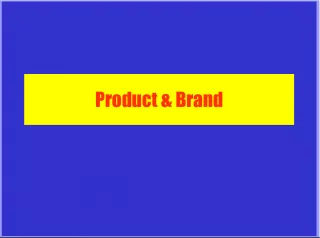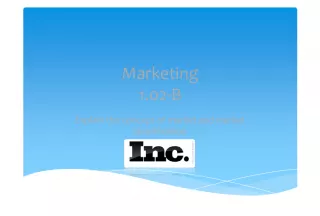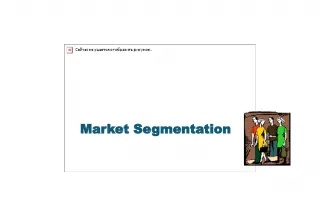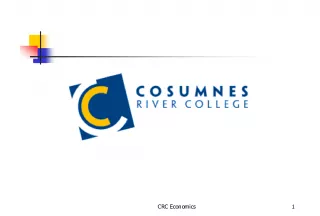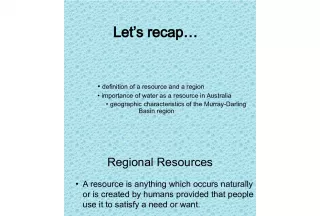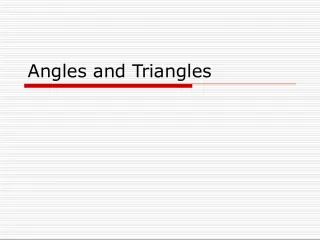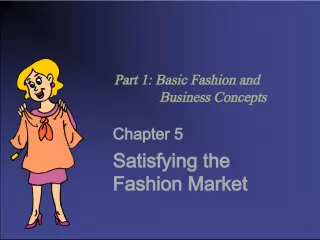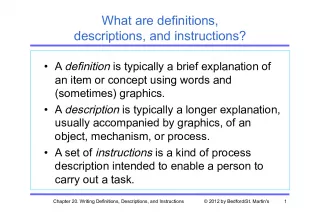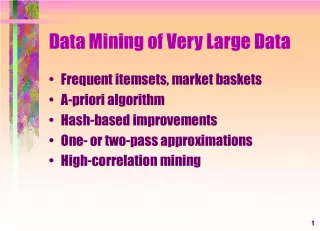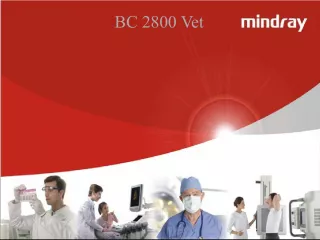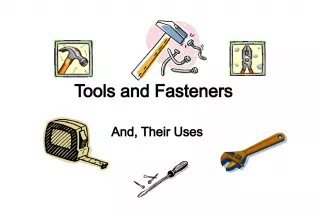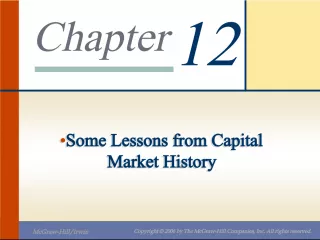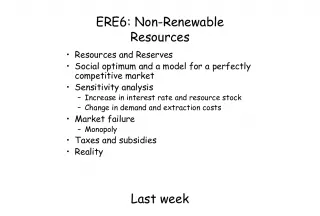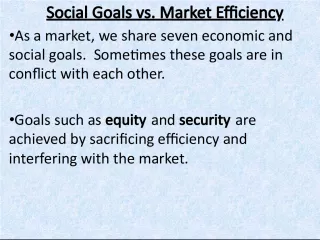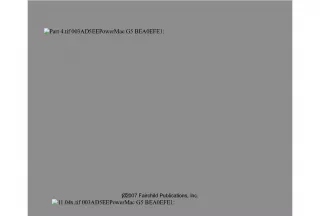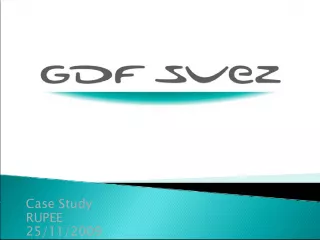Market Characteristics and Definitions
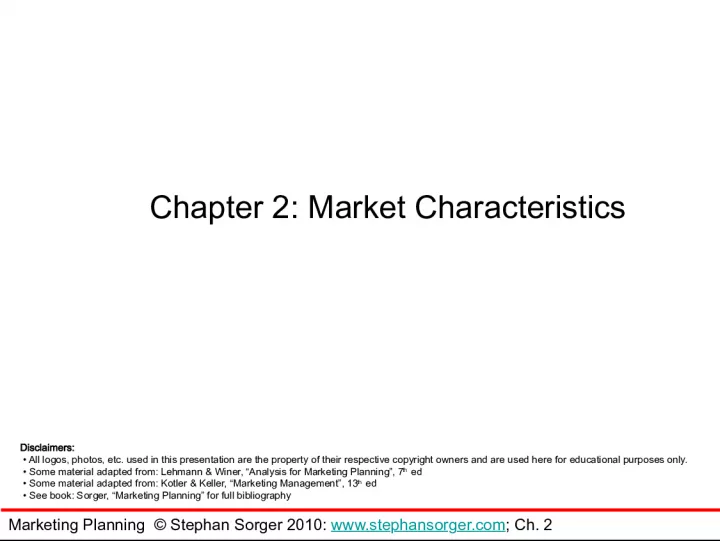

This chapter discusses the differences between market, industry, and category definitions. It also includes disclaimers regarding the use of copyrighted materials.
- Uploaded on | 0 Views
-
 evanmurray
evanmurray
About Market Characteristics and Definitions
PowerPoint presentation about 'Market Characteristics and Definitions'. This presentation describes the topic on This chapter discusses the differences between market, industry, and category definitions. It also includes disclaimers regarding the use of copyrighted materials.. The key topics included in this slideshow are Market, industry, category, definition, customer need,. Download this presentation absolutely free.
Presentation Transcript
1. Chapter 2: Market Characteristics Disclaimers: All logos, photos, etc. used in this presentation are the property of their respective copyright owners and are used here for educational purposes only. Some material adapted from: Lehmann & Winer, Analysis for Marketing Planning, 7 th ed Some material adapted from: Kotler & Keller, Marketing Management, 13 th ed See book: Sorger, Marketing Planning for full bibliography Marketing Planning Stephan Sorger 2010: www.stephansorger.com ; Ch. 2
2. Market/ Industry/ Category Definition Term Definition Market Customer need satisfied by business (vs. product) See Product definition vs. Market definition below Industry Group of firms offering products seen as substitutes Example: White goods (appliance) industry: GE Category Group of competing firms; subset of industry Example: High-end appliances: Sub Zero Company Product Definition Market Definition Wang (1980s) We make word processors We help process documents Sony BMG (Music) We sell CDs We market entertainment Encyclopedia Brittanica We sell encyclopedias We distribute information Microsoft We make operating systems We make it easy to use PCs Marketing Planning Stephan Sorger 2010: www.stephansorger.com ; Ch. 2 Situation Anyl. I: 2.3
3. Market Characteristics Term Definition Size Bigger = Better, usually Growth Faster = Better, usually Cyclicity Multi-year sales cycles; Stable = better, usually Seasonality Multi-month sales cycles; Stable = better, usually The real estate market is seasonal: Sales in January & February are almost always lower than the rest of the year Marketing Planning Stephan Sorger 2010: www.stephansorger.com ; Ch. 2 Situation Anyl. I: 2.4
4. Factor Description Life Cycle Stages: Intro, Growth, Maturity, Decline Growth stage: Good, but not guaranteed Mature stage: Profitable if done right Stage Introduction Growth Maturity Decline Category Size Small Moderate Large Moderate Category Growth Low High Low Negative Attractiveness Low High Low/High Low Sales time Market Characteristics: Life Cycle Marketing Planning Stephan Sorger 2010: www.stephansorger.com ; Ch. 2 Situation Anyl. I: 2.5
5. Market Attractiveness: The Porter Five Forces Model Power of Suppliers Power of Customers Substitute Products (and capacity) New Entrants Rivalry Business Why study attractiveness? - Determine if market worth investing in (or continuing to invest in) - Avoid bad surprises later Marketing Planning Stephan Sorger 2010: www.stephansorger.com ; Ch. 2 Situation Anyl. I: 2.6
6. Conditions Description/ Examples Product essential Product large % of buyers costs Auto: Steel; Replaced by plastic Undifferentiated Buyers view product as commodity Computers: Bulk semiconductors Backward integration Buyers go around suppliers Consumers: Do It Yourself; Home Depot Full information Buyers aware of competitive offerings Car dealer: Negotiate using invoice price Porter Five Forces Model: Power of Customers - Customers force down prices Profits Drop Marketing Planning Stephan Sorger 2010: www.stephansorger.com ; Ch. 2 Situation Anyl. I: 2.7
7. Conditions Description/ Examples Concentrated Dominated by a few firms PC Operating Systems: Microsoft No Substitute No replacement in short term OPEC Switching Costs Supplier makes it difficult to switch Software Limited Supply Few resources available Electronics: Shortage of essential chips Porter Five Forces Model: Power of Suppliers - Suppliers dictate terms Profits Drop Marketing Planning Stephan Sorger 2010: www.stephansorger.com ; Ch. 2 Situation Anyl. I: 2.8
8. Conditions Description/ Examples Exception Proprietary product filling unique need iPod amidst all other MP3 players; price premium Porter Five Forces Model: Power of Substitutes & Capacity Substitutes - Many substitutes Profits Drop Conditions Description/ Examples Recession Hotels vacant, so prices drop Capacity - Overcapacity Profits Drop Marketing Planning Stephan Sorger 2010: www.stephansorger.com ; Ch. 2 Situation Anyl. I: 2.9
9. Barrier Description/ Examples Economies of scale High fixed costs High volume Hospital supplies: Fixed order & fulfillment costs Product differentiation Well-established brand names Cereal: Kellogg, Kraft, General Mills, Quaker Capital requirements Many $ to start operations Fast Food: $$$ for marketing & distribution Switching costs $ to switch from Supplier A to Supplier B Software: Difficult to switch: Oracle SAP Distribution Shelf space difficult to get Expensive slotting fees for space Porter Five Forces Model: Threat of New Entrants - New Entrants Profits Drop - Solution: Erect barriers to entry Marketing Planning Stephan Sorger 2010: www.stephansorger.com ; Ch. 2 Situation Anyl. I: 2.10
10. Conditions Description/ Examples Balanced competitors Near-equals in size & power Home Depot & Lowes Slow growth Steal market share from competitor Cell phones carriers: Verizon, Cingular, Sprint Differentiation Products look the same Cell phones: Apple iPhone differentiator Porter Five Forces Model: Rivalry - Handful of Competitors Dominate Profits Drop Marketing Planning Stephan Sorger 2010: www.stephansorger.com ; Ch. 2 Situation Anyl. I: 2.11
11. Rivalry: Top 1-2 Brands Dominate Market Brand Value Interbrand Brand Strength New Brand #3 Brand #1 or #2 Brand 0% 100% $ Low $ High #1 Brand worth significantly more than # 3 brand Example Rivals: Democrat & Republican Coke & Pepsi UPS & FedEx American & United Airlines Home Depot & Lowes GM & Ford Hertz & Avis Intel & AMD Marketing Planning Stephan Sorger 2010: www.stephansorger.com ; Ch. 2 Situation Anyl. I: 2.12
12. PEST Analysis Political Economic Social Technological Marketing Planning Stephan Sorger 2010: www.stephansorger.com ; Ch. 2 Situation Anyl. I: 2.13
13. PEST Analysis: Political PEST Component Example Political Tax policy Employment laws Environmental regulations. Trade restrictions and tariffs Political stability Partisan politics Governmental policies can change significantly depending on whether Democrats or Republicans control Congress Marketing Planning Stephan Sorger 2010: www.stephansorger.com ; Ch. 2 Situation Anyl. I: 2.14
14. PEST Analysis: Economic PEST Component Example Economic Economic growth Interest rates Exchange rates Inflation rate Recession/ Depression In a recession/ depression, almost every market falls Marketing Planning Stephan Sorger 2010: www.stephansorger.com ; Ch. 2 Situation Anyl. I: 2.15
15. PEST Analysis: Social PEST Component Example Social Attitudes toward outsourcing Career attitudes Emphasis on safety Generation X, Y, N: Skeptical; Bombarded with ads Boomers: Audi R8 for midlife crisis Trends: Diversity, convenience, individualism (?) Audi designed its R8 specifically for the Baby Boomer midlife crisis market segment Marketing Planning Stephan Sorger 2010: www.stephansorger.com ; Ch. 2 Situation Anyl. I: 2.16
16. PEST Analysis: Technological PEST Component Example Technological GPS: New economy iPhone: New economy Internet: New economy Hybrid cars: New trend New fuels: Impact? A technological change from gasoline to hydrogen fuel would have a major impact on the automotive market Marketing Planning Stephan Sorger 2010: www.stephansorger.com ; Ch. 2 Situation Anyl. I: 2.17
17. Business Market: SIC/ NAICS Codes Term Description SIC Standard Industrial Classification 1987: Started by US government; Similar to USPS ZIP code Table includes all possible types of industries; popular More digits More specific industry segment NAICS North American Industrial Classification System: 20 Sectors 1997, 2002: Replaced SIC code to include more segments 51 - Information 513 Broadcasting & Telecommunications 5133 Telecommunications 51334 Satellite Telecommunications 513340 Satellite Telecommunications www.census.gov/naics Marketing Planning Stephan Sorger 2010: www.stephansorger.com ; Ch. 2 Situation Anyl. I: 2.18
18. Business Market: NAICS Example Estimating Market Size using Market Buildup Method Example: Acme Searchlights, manufacturing lights for key markets: - Airports NAICS 488119 - Motion Picture Production NAICS 512110 - Automotive Dealerships NAICS 441120 - Naval Ships NAICS 336611 Marketing Planning Stephan Sorger 2010: www.stephansorger.com ; Ch. 2 Situation Anyl. I: 2.19
19. Factor Description Attractiveness Aggregate Market Size 139 Million devices (gartner.com) + Growth 12-15% (ibtimes.com) + Life Cycle Growth + Cyclicity None/ Low +/0 Seasonality None/ Low +/0 Competitive Entries/ Exits Google Ion; Samsung Omnia, etc. - Power of buyers Low; Only one carrier/ smartphone + Power of suppliers Moderate; PCs use similar parts 0 Rivalry Intense; Heavy competition - Substitutes Moderate; different types of phones - Capacity usage Criticisms of slow phone provisioning 0/- PEST Political/ Regulatory Possible telecomm regulations 0/- Economic Relatively inexpensive + Social Mobile lifestyle + Technological Intense - Example: Apple iPhone Marketing Planning Stephan Sorger 2010: www.stephansorger.com ; Ch. 2 Situation Anyl. I: 2.20
